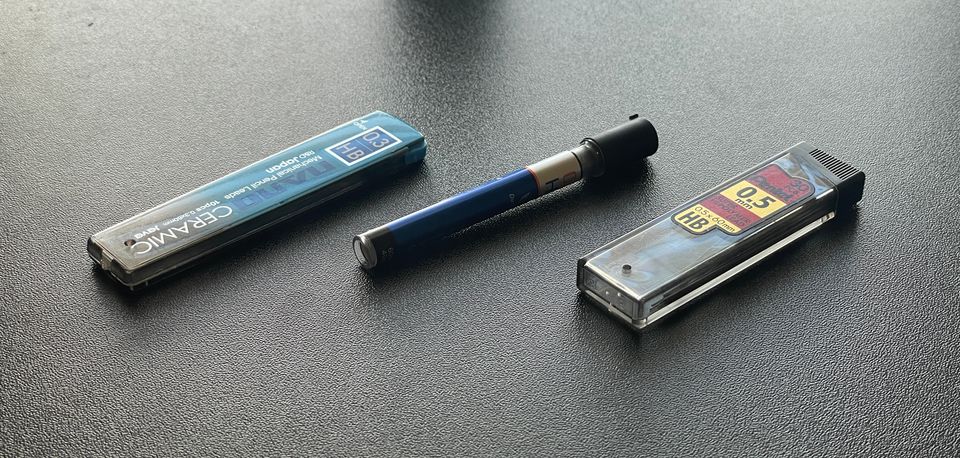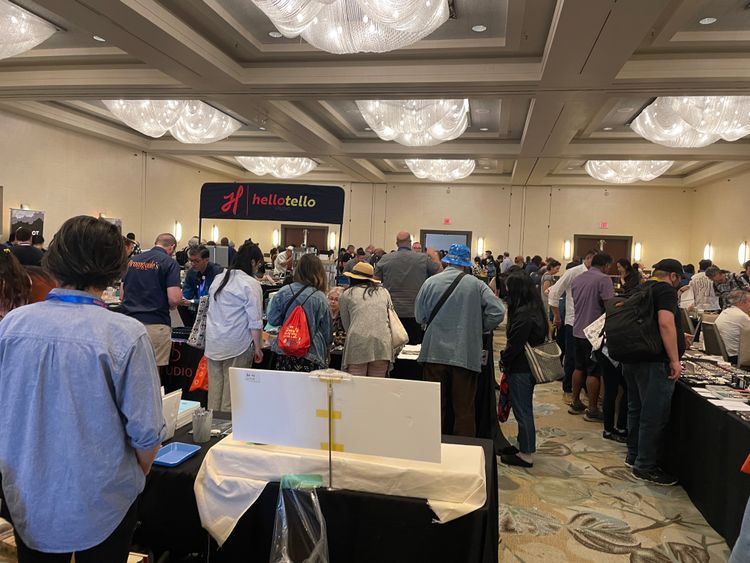Mechanical Pencil Lead Hardness Explained

You may have wondered what "HB" or "2B" means. The lettering, such as HB (Hard Black), tells the user what type of lead is inside the mechanical pencil. Mechanical pencils often feature a dial that allows you to change what the indicator displays to keep track of what lead is in there.
Below is a list of the most common lead grades and their equivalent in terms of the US pencil grading system. However, keep in mind that there are many more lead grades than the ones show in this table.
| Grade | Meaning | Equivalent |
|---|---|---|
| 2H | Extra Hard | No. 4 Pencil |
| H | Hard | No. 3 Pencil |
| F | Fine | No. 2.5 Pencil |
| HB | Hard Black | No. 2 Pencil |
| B | Soft Black | No. 1 Pencil |
This feature is essential for artists and others with a mountain of mechanical pencils that look identical. Let's say an artist enjoyed using a specific type of mechanical pencil, the Rotring, 600 and had five silver versions with various harnesses inside. It'd be impossible to distinguish which kind of lead is in each one without some lead indicator.
I admit that example is quite extreme, but it conveys the importance of lead hardness indicators. Even though most casual users of mechanical pencils stick with HB lead, the industry standard, the different degrees of hardness are beneficial since they can provide different properties, from a more rigid, lighter-tone line to a darker line with a deep shade.
If the various grades of leads get confusing, remember this:
- HB and F are in the middle ground
- B is darker (with each added number in front adding to said darkness)
- H is lighter (with each added number in front, making it appear lighter).
Hardness is a measurement of how much lead is put on the page. Harder leads put out less lead than softer leads with the same applied pressure. This hardness also makes it so that the lead doesn't smear when on the page.
Characteristics of lead come from the material makeup of each grade. Pencils leads are comprised of a mix of graphite and clay, so more graphite in the lead contributes to a softer pencil and vice versa.

Of course, each lead grade will look different with the different compositions. Below is a handy chart comparing various lead hardness levels.

Characteristics of Each Lead Grade
HB Lead
HB is the standard lead size. The vast majority of mechanical pencils (and regular pencils, too!) are included with HB lead. This lead's popularity is warranted as it's approximately equal to the dominant No. 2 wooden pencils (i.e., the Ticonderoga yellow wooden pencils with green text).
HB will do the job in terms of everyday work - from homework to sketching. It's a perfect blend; this lead is relatively smudge resistant while maintaining a solidly dark line that can be erased relatively easily.
Given the popularity, it's also straightforward to get refills for HB leads. You can locate HB lead refills at nearly any store that sells mechanical pencils. I use Zebra DelGuard HB lead and Pentel Super Hi-Polymer HB lead in my mechanical pencils. However, I'd also recommend Pentel's Ain Stein lead.
2H and Harder Lead
Lead grades of 2H and harder (3H, 4H, etc.) are mainly designed for technical drawing (think detailed graphs, such as an engineer's model of how something works). From the table above, you can see that there's comparatively more clay.
These aren't exactly meant for everyday writing and more so for experts. The line will be a lighter shade compared to HB, with each increment in grade putting down an even lighter line. Currently, some 2H lead is available on Amazon.
2H and harder leads produce a clean line that doesn't smudge. Use them for lighter tones and more precise workings. I don't use 2H leads at this time, so I can't recommend any.
H and F Lead
H and F lead grades are suitable for daily writing but not too mainstream. F is slightly harder than HB, and H is slightly harder than F. Finding these in stores will be pretty hard. However, Amazon has a plentiful amount of H lead and F lead available online if you want to try them out.
They both write pretty well and are relatively comparable to HB. However, H and F leads write slightly lighter but smear less than HB. I only have a little experience with these lead grades now, so I can't give specific recommendations, but trying them out is fun!
B and Softer Lead
Now, we're getting into the softer sizes. These grades write smoother than HB but smear to a greater degree. I've had better luck seeing B grades (specifically 2B) in the real world, whether at Daiso or any other store. From the graph above, these grades have much more graphite than others.
I'd say that the B grades (B, 2B, etc.) are the most common, probably due to the amount of artists using them. Of course, Amazon has B lead and 2B lead available.
I've actually used 2B on my homework assignments in the past. It's messier than HB, and I'd be more careful when using this lead. B grades are fun to write with and put a darker line on the page. However, that comes at the cost of residue all over the page after you're done. Regardless, I'd recommend trying B leads some time.
These are the fundamentals of different lead grades in mechanical pencils. I recommend trying as many different grades of lead because they're really fun to play with. The next time you need a refill for your mechanical pencil, try a new grade (but stick to one of the more common ones from the table at the top)! Good luck with your pencil journey!






Comments ()